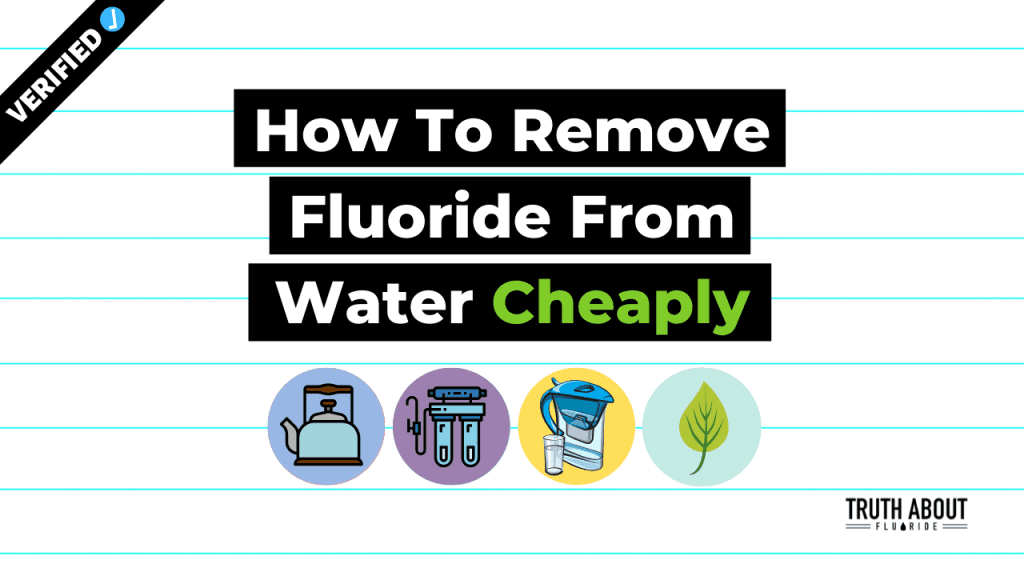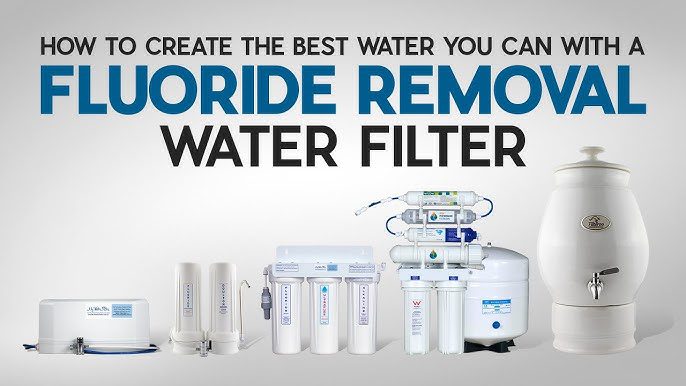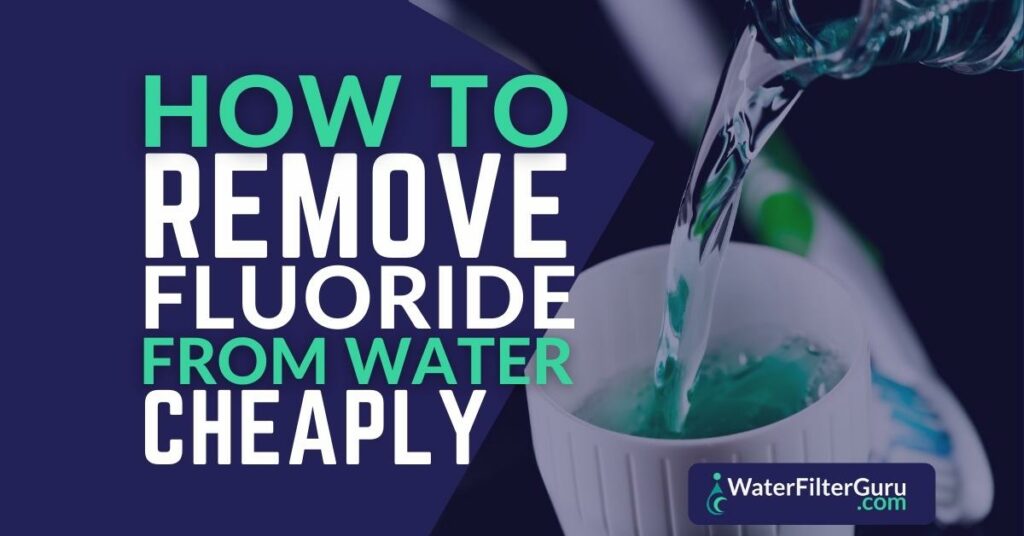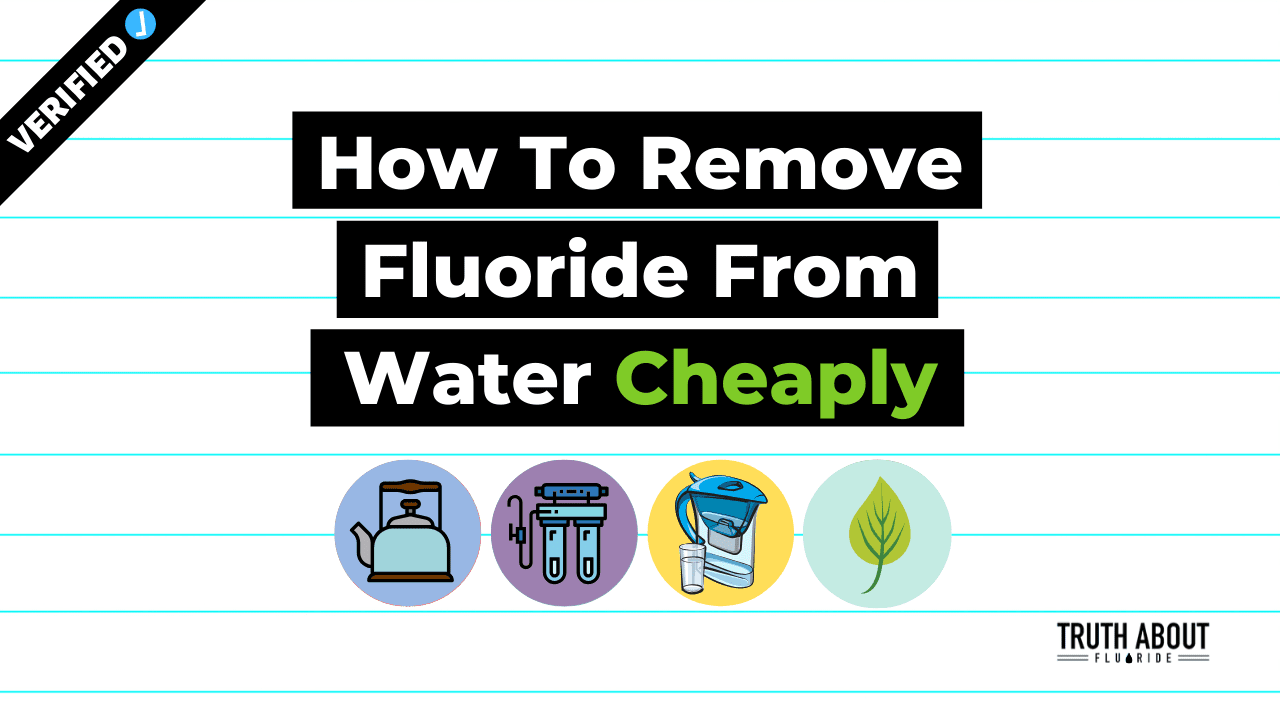Have you ever wondered if it’s possible to remove fluoride from water without using a filter? Well, the good news is that there are indeed alternative methods that you can try. Whether you’re concerned about the potential health effects of fluoride or you simply prefer a filter-free approach, this article will explore some effective ways to reduce fluoride levels in your drinking water. From boiling to using certain additives, we’ve got you covered with simple and practical solutions to help you enjoy fluoride-free water. So, let’s dive into this fascinating topic and discover how you can achieve cleaner, purer water without relying on a filter!


This image is property of truthaboutfluoride.com.
Using Activated Alumina
Understanding Activated Alumina
Activated alumina is a highly effective material used for the removal of fluoride from water. It is an adsorbent that works by attracting and retaining fluoride ions in its pores, thus reducing their concentration in the water. Activated alumina is made from aluminum hydroxide, which is then activated through a process of heating and drying. This activation increases the material’s surface area, making it highly porous and capable of adsorbing various impurities, including fluoride.
Process of Fluoride Removal using Activated Alumina
The process of fluoride removal using activated alumina involves passing water through a bed of activated alumina beads. As the water flows through the bed, fluoride ions are adsorbed onto the surfaces of the alumina beads, effectively reducing the fluoride concentration in the treated water. It is important to note that activated alumina is more effective in removing fluoride from neutral to slightly alkaline water conditions.
Application and Considerations
Activated alumina is commonly used in point-of-use water filters and water treatment systems specifically designed for fluoride removal. It can also be used in certain industrial applications where the presence of fluoride needs to be reduced. When using activated alumina for fluoride removal, it is important to consider the water pH, as acidic water may decrease the material’s effectiveness. Additionally, regular regeneration or replacement of the activated alumina bed is necessary to maintain optimal efficiency.
Advantages and Disadvantages
One of the main advantages of using activated alumina for fluoride removal is its high adsorption capacity. It is capable of reducing fluoride concentrations to levels well below the acceptable limits set by regulatory authorities. Furthermore, activated alumina is a cost-effective solution compared to some other methods of fluoride removal. However, it is important to note that activated alumina can also remove beneficial minerals from the water, which may require mineral supplementation in certain cases.
Using Bone Char
What is Bone Char?
Bone char is a type of carbon material derived from animal bones, usually obtained from cattle. It is widely used in various applications, including water treatment, due to its adsorptive properties. In the context of fluoride removal, bone char works by adsorbing fluoride ions onto its surface, effectively reducing their concentration in water.
Fluoride Removal with Bone Char
The process of fluoride removal using bone char involves passing water through a bed or filter containing bone char. As the water comes into contact with the bone char, fluoride ions are adsorbed onto its surface, leading to a reduction in fluoride concentration. It is worth noting that bone char is particularly effective in removing fluoride from water with a pH range of 5 to 8.
Effectiveness and Limitations
Bone char is known for its high affinity for fluoride ions, making it an efficient material for fluoride removal. It can effectively reduce fluoride levels to below the recommended limits. However, the effectiveness of bone char may vary depending on water pH and other water quality parameters. It is important to regularly test the treated water to ensure that it meets the desired fluoride concentration.
Precautions to Take
When using bone char for fluoride removal, it is crucial to ensure that the bone char is food-grade and free from any contaminants. Proper filtration and maintenance of the bone char bed or filter are also necessary to prevent bacterial growth. Additionally, it is advisable to replace the bone char periodically to maintain its adsorption capacity and efficiency.
Using Reverse Osmosis
Introduction to Reverse Osmosis
Reverse osmosis (RO) is a popular water purification method that utilizes a semipermeable membrane to remove various impurities, including fluoride. In a reverse osmosis system, water is forced through the membrane, which allows water molecules to pass through while blocking the passage of larger molecules and ions, such as fluoride.
Fluoride Removal by Reverse Osmosis
The process of fluoride removal by reverse osmosis involves the use of a reverse osmosis system, typically consisting of a pre-filter, a semipermeable membrane, and a post-filter. As water passes through the membrane, fluoride ions are effectively rejected, resulting in a reduced fluoride concentration in the treated water. Reverse osmosis is particularly effective in removing fluoride, achieving removal rates of up to 95-98%.
Maintenance and Drawbacks
To ensure the optimal performance of a reverse osmosis system, regular maintenance is essential. This includes replacing pre-filters and the semipermeable membrane according to the manufacturer’s instructions. Additionally, reverse osmosis systems produce wastewater, which should be properly disposed of. It is also worth noting that the process of reverse osmosis removes not only fluoride but also other beneficial minerals from the water, requiring remineralization if desired.
Suitability and Cost Considerations
Reverse osmosis systems are suitable for both point-of-use and point-of-entry applications, depending on the specific needs and water quality requirements. While they are effective in removing fluoride, it is important to consider the initial investment and ongoing maintenance costs associated with such systems. It may be necessary to consult a water treatment professional to determine the right reverse osmosis system for your specific situation.
Using Distillation
Understanding Distillation
Distillation is a water treatment method that involves heating water to its boiling point and then collecting and condensing the resulting steam. The process effectively separates contaminants, including fluoride, from the water since most impurities do not vaporize at the same temperature as water.
Fluoride Removal through Distillation
The process of fluoride removal through distillation involves boiling water and then collecting the steam, which is then condensed back into liquid form. Since fluoride does not vaporize at the same temperature as water, the distilled water obtained is typically fluoride-free or has a significantly reduced fluoride concentration.
Challenges and Tips
One of the challenges with using distillation for fluoride removal is the potential loss of beneficial minerals during the process. Therefore, it is important to ensure a balanced diet and consider consuming mineral-rich foods or obtaining mineral supplements if relying on distilled water for extended periods. Additionally, it is crucial to clean and maintain the distillation equipment regularly to prevent buildup and potential contamination.
Considerations before Choosing Distillation
While distillation can effectively remove fluoride from water, it is worth considering certain aspects before choosing this method. The process is relatively slow compared to other methods, requiring time for the water to heat up and for the steam to condense. Additionally, distillation can be energy-intensive and may not be suitable for large-scale water treatment. Careful consideration of these factors is necessary to determine if distillation is the right choice for fluoride removal in your specific circumstances.


This image is property of i.ytimg.com.
Using Moringa Seeds
Moringa Seeds for Water Treatment
Moringa seeds have long been used for their water purification properties, including the removal of fluoride. The seeds contain natural coagulants that aid in the clarification and purification of water, making them a suitable option for communities where fluoride contamination is a concern.
Fluoride Removal Process with Moringa Seeds
The process of fluoride removal using moringa seeds involves crushing the seeds and adding them to water that contains high levels of fluoride. The crushed seeds release natural coagulants that bind to fluoride ions, allowing them to settle at the bottom of the container. The water can then be decanted, leaving behind a significantly reduced fluoride concentration.
Effectiveness and Precautions
Moringa seeds are known for their effectiveness in reducing fluoride levels in water. Studies have shown that they can effectively remove up to 90% of fluoride, making them a viable option for fluoride-contaminated water. However, it is important to note that the effectiveness of moringa seeds may vary depending on the water quality and seed characteristics. Proper dosage and processing techniques should be followed to achieve the desired results. Additionally, it is important to use clean and uncontaminated moringa seeds for effective fluoride removal.
Availability and Sustainability
Moringa trees are native to many regions and are cultivated widely, making the seeds relatively accessible in these areas. However, it is crucial to ensure that the moringa seeds used for fluoride removal are sourced sustainably to prevent negative impacts on the environment and local ecosystems. Proper harvesting and processing practices, as well as reforestation efforts, can contribute to the sustainable use of moringa seeds for fluoride removal.
Using Boiling Method
Boiling Water for Fluoride Removal
Boiling water is one of the simplest and most accessible methods for fluoride removal, especially in emergency situations or when other methods are not readily available. When water is boiled for a certain period of time, the fluoride ions present tend to evaporate, resulting in a reduced fluoride concentration.
Limitations and Effectiveness
While boiling water can effectively reduce fluoride levels to some extent, it is important to note that it may not completely remove all fluoride ions. The effectiveness of this method depends on various factors, such as the initial fluoride concentration, the duration of boiling, and the temperature reached during boiling. It is advisable to consult local health authorities or experts to determine the appropriate boiling time for effective fluoride removal.
Safety Considerations
When using the boiling method for fluoride removal, it is essential to ensure the water is brought to a rolling boil, where large bubbles consistently break the surface. This helps ensure that the water has reached the necessary temperature to drive off the fluoride ions. Additionally, it is important to handle the hot water with caution to prevent burns or injuries.
Alternative Uses of Boiling Method
Aside from fluoride removal, boiling water has several other practical applications. It is commonly used to kill harmful microorganisms and make water safe for drinking by reducing the risk of waterborne diseases. Boiling water can also be used for general sterilization purposes, such as disinfecting cooking utensils or baby bottles when access to clean water is limited.


This image is property of truthaboutfluoride.com.
Using Bentonite Clay
Introduction to Bentonite Clay
Bentonite clay is a naturally occurring clay mineral with excellent adsorption properties. It is widely used for various purposes, including water purification and the removal of contaminants such as fluoride. Bentonite clay is composed mainly of montmorillonite, which gives it the ability to attract and bind to fluoride ions.
Fluoride Removal using Bentonite Clay
The process of fluoride removal using bentonite clay involves mixing the clay with water and allowing it to settle. As the bentonite clay particles settle, they effectively adsorb fluoride ions, leading to a reduction in fluoride concentration. The treated water can then be decanted or filtered to separate the clay from the purified water.
Effectiveness and Side Effects
Bentonite clay is known for its high adsorption capacity, making it an effective material for fluoride removal. It can significantly reduce fluoride levels in water, making it suitable for areas with high fluoride concentrations. However, it is important to note that bentonite clay may also remove beneficial minerals from water. In certain cases, mineral supplementation may be necessary to ensure a balanced diet.
Choosing and Applying Bentonite Clay
When choosing bentonite clay for fluoride removal, it is crucial to ensure that you are using food-grade or drinking water-grade clay to avoid potential contaminants. Additionally, properly following the recommended dosage and application methods is essential to achieve the desired fluoride removal. It is advisable to consult experts or conduct research to determine the appropriate bentonite clay type and application process for your specific needs.
Using Ion Exchange Resins
Understanding Ion Exchange Resins
Ion exchange resins are synthetic materials with a porous structure that can remove certain ions from water through an exchange process. These resins typically contain functional groups that selectively attract and bind to specific ions, such as fluoride ions, while releasing other ions, such as chloride or hydroxide.
Fluoride Removal with Ion Exchange Resins
The process of fluoride removal with ion exchange resins involves passing water through a resin bed or column packed with resin beads. As the water flows through the resin bed, fluoride ions are exchanged with other ions, typically hydroxide ions, on the resin surface. This results in a significant reduction in fluoride levels in the treated water.
Considerations and Long-term Costs
When considering the use of ion exchange resins for fluoride removal, it is important to note that the resin beads will eventually reach their capacity for fluoride adsorption and require regeneration or replacement. The frequency of regeneration or replacement depends on the fluoride concentration in the influent water and the resin’s capacity. Long-term costs associated with resin replacement and regeneration should be taken into account when evaluating the suitability of ion exchange resins for fluoride removal.
Maintenance and Regeneration
Regular maintenance of ion exchange resin systems is crucial to ensure optimal performance. This includes periodic regeneration of the resin bed to restore its adsorption capacity. Regeneration typically involves passing a concentrated solution of hydroxide or chloride ions through the resin bed to displace the adsorbed fluoride ions. Following manufacturer guidelines for regeneration and proper disposal of the regenerant solution is essential to prevent environmental impact.


This image is property of waterfilterguru.com.
Using Activated Carbon
Activated Carbon for Water Treatment
Activated carbon, also known as activated charcoal, is a highly porous form of carbon that is widely used for water treatment. It is produced by heating carbonaceous materials, such as wood or coconut shells, at high temperatures to create a network of small pores that increase its surface area and adsorption capacity.
Fluoride Removal by Activated Carbon
The process of fluoride removal by activated carbon involves passing water through a bed or column packed with activated carbon granules or blocks. As the water flows through the carbon bed, fluoride ions are adsorbed onto the carbon surfaces, effectively reducing the fluoride concentration in the treated water. This process relies on the strong adsorption properties of activated carbon.
Effectiveness and Adsorption Capacity
Activated carbon is known for its high adsorption capacity for various impurities, including fluoride. It can effectively reduce fluoride levels to below the acceptable limits set by regulatory authorities. However, it is important to note that the adsorption capacity of activated carbon is finite and can become exhausted over time. Regular replacement or regeneration of the activated carbon bed is necessary to maintain optimal fluoride removal efficiency.
Application and Precautions
Activated carbon is commonly used in point-of-use water filters and point-of-entry systems designed for fluoride removal. It can also be combined with other filtration or treatment methods to enhance overall water purification. When using activated carbon for fluoride removal, it is essential to follow the recommended maintenance schedule and replace the carbon filter according to the manufacturer’s instructions. It is also important to consider potential fouling or bacterial growth within the carbon bed and take appropriate precautions to prevent contamination.
Natural Remedies and At-Home Techniques
Lemon Juice and Vinegar Solution
A popular at-home technique for fluoride removal involves using a solution of lemon juice and vinegar. The acid in the lemon juice and vinegar has been believed to aid in reducing fluoride levels in water. However, it is important to note that the effectiveness of this method is limited and may not be as reliable as other established methods of fluoride removal.
Fruit Peels and Citrus Fruits
Some fruit peels and citrus fruits, such as oranges and lemons, have been suggested as potential natural remedies for fluoride removal. It has been proposed that the compounds present in these fruits, such as limonene, may aid in reducing fluoride levels in water. However, further research is needed to validate the efficacy of this method.
Chlorine Evaporation
Another at-home technique for fluoride removal is chlorine evaporation. This method involves leaving tap water in an open container for a certain period of time to allow chlorine, which is often added to municipal water supplies, to evaporate. It is important to note that while this method may reduce chlorine levels, it may not effectively remove fluoride or other contaminants from water.
Freezing Method
The freezing method is an interesting at-home technique that involves allowing tap water to freeze and then discarding the ice. It is believed that during the freezing process, impurities, including fluoride, may be concentrated in the ice, resulting in reduced fluoride levels in the remaining liquid water. However, it is important to note that the freezing method may not completely remove all fluoride ions, and its effectiveness may vary depending on various factors.
In conclusion, there are several methods available for removing fluoride from water without a filter. Each method has its own advantages, disadvantages, and considerations. Activated alumina, bone char, reverse osmosis, distillation, moringa seeds, boiling, bentonite clay, ion exchange resins, activated carbon, and various natural remedies all offer varying degrees of effectiveness and suitability depending on the specific needs and circumstances. It is important to carefully evaluate and choose the most appropriate method based on water quality, cost considerations, safety precautions, and long-term maintenance requirements. Consulting with water treatment professionals or experts in the field can help ensure the best possible fluoride removal outcome. Remember, the goal is to provide clean and safe water for you and your loved ones.


This image is property of truthaboutfluoride.com.




